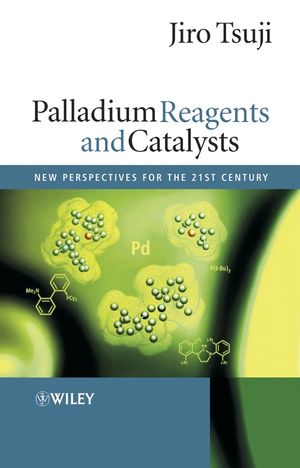Palladium Reagents and Catalysts: New Perspectives for the 21st CenturyISBN: 978-0-470-85032-9
Hardcover
670 pages
June 2004
 This is a Print-on-Demand title. It will be printed specifically to fill your order. Please allow an additional 15-20 days delivery time. The book is not returnable.
|
||||||
Abbreviations.
1 The Basic Chemistry of Organopalladium Compounds.
1.1 Characteristic Features of Pd-Promoted or –Catalyzed Reactions.
1.2 Palladium Compounds, Complexes, and Ligands Widely Used in Organic Synthesis.
1.3 Fundamental Reactions of Pd Compounds.
1.3.1 ‘Oxidative’ Addition.
1.3.2 Insertion.
1.3.3 Transmetallation.
1.3.4 Reductive Elimination.
1.3.5 β-H Elimination (β-Elimination, Dehydropalladation).
1.3.6 Elimination of β-Heteroatom Groups and β-Carbon.
1.3.7 Electrophilic Attack by Organopalladium Species.
1.3.8 Termination of Pd-Catalyzed or –Promoted Reactions and a Catalytic Cycle.
1.3.9 Reactions Involving Pd(II) Compounds and Pd(0) Complexes.
References.
2 Oxidative Reactions with Pd(II) Compounds.
2.1 Introduction.
2.2 Reactions of Alkenes.
2.2.1 Introducti on.
2.2.2 Reaction with Water.
2.2.3 Reactions with Alcohols and Phenols.
2.2.4 Reactions with Carboxylic Acids.
2.2.5 Reactions with Amines.
2.2.6 Reactions with Carbon Nucleophiles.
2.2.7 Oxidative Carbonylation.
2.2.8 Reactions with Aromatic Compounds.
2.2.9 Coupling of Alkenes with Organometallic Compounds.
2.3 Stoichiometric Reactions of π-Allyl Complexes.
2.4 Reactions of Conjugated Dienes.
2.5 Reactions of Allenes.
2.6 Reaction of Alkynes.
2.7 Homocoupling and Oxidative Substitution Reactions of Aromatic Compounds.
2.8 Regioselective Reactions Based on Chelation and Participation of Heteroatoms.
2.9 Oxidative Carbonylation of Alcohols and Amines.
2.10 Oxidation of Alcohols.
2.11 Enone Formation from Ketones and Cycloalkenylation.
References.
3 Pd(0)-Catalyzed Reactions of sp2Organic Halides and Pseudohalides.
3.1 Introduction.
3.2 Reactions with Alkenes (Mizoroki–Heck Reaction).
3.2.1 Introduction.
3.2.2 Catalysts and Ligands.
3.2.3 Reaction Conditions (Bases, Solvents, and Additives).
3.2.4 Halides and Pseudohalides.
3.2.5 Alkenes.
3.2.6 Formation of Neopentylpalladium and its Termination by Anion Capture.
3.2.7 Intramolecular Reactions.
3.2.8. Asymmetric Reactions.
3.2.9 Reactions with 1,2-, 1,3-, and 1,4-Dienes.
3.2.10 Amino Heck Reactions of Oximes.
References.
3.3 Reactions of Aromatics and Heteroaromatics.
3.3.1 Arylation of Heterocycles.
3.3.2 Intermolecular Arylation of Phenols.
3.3.3 Intermolecular Polyarylation of Ketones.
3.3.4 Intramolecular Arylation of Aromatics.
References.
3.4 Reactions with Alkynes.
3.4.1 Introduction.
3.4.2 Reactions of Terminal Alkynes to Form Aryl- and Alkenylalkynes (Sonogashira Coupling).
References.
3.4.3 Reactions of Internal and Terminal Alkynes with Aryl and Alkenyl Halides via Insertion.
References.
3.5 Carbonylation and Reactions of Acyl Chlorides.
3.5.1 Introduction.
3.5.2 Formation of Carboxylic Acids, Esters, and Amides.
3.5.3 Formation of Aldehydes and Ketones.
3.5.4 Reactions of Acyl Halides and Related Compounds.
3.5.5 Miscellaneous Reactions.
References.
3.6 Cross-Coupling Reactions with Organometallic Compounds of the Main Group Metals via Transmetallation.
3.6.1 Introduction.
3.6.2 Organoboron Compounds (Suzuki–Miyaura Coupling).
References.
3.6.3 Organostannanes (Kosugi–Migita–Stille Coupling).
3.6.4 Organozinc Compounds (Negishi Coupling).
3.6.5 Organomagnesium Compounds.
3.6.6 Organosilicon Compounds (Hiyama Coupling).
References.
3.7 Arylation and Alkenylation of C, N, O, S, and P Nucleophiles.
3.7.1 α-Arylation and α-Alkenylation of Carbon Nucleophiles.
3.7.2 Intramolecular Attack of Aryl Halides on Carbonyl Groups.
References.
3.7.3 Arylation of Nitrogen Nucleophiles.
References.
3.7.4 Arylation of Phenols, Alcohols, and Thiols.
References.
3.7.5 Arylation of Phosphines, Phosphonates, and Phosphinates.
References.
3.8 Miscellaneous Reactions of Aryl Halides.
3.8.1 The Catellani Reactions using Norbornene as a Template for ortho-Substitution.
References.
3.8.2 Reactions of Alcohols with Aryl Halides Involving β-Carbon Elimination.
References.
3.8.3 Hydrogenolysis with Various Hydrides.
3.8.4 Homocoupling of Organic Halides (Reductive Coupling).
References.
4 Pd(0)-Catalyzed Reactions of Allylic Compounds via Π-Allylpalladium Complexes.
4.1 Introduction and Range of Leaving Groups.
4.2 Allylation.
4.2.1 Stereo- and Regiochemistry of Allylation.
4.2.2 Asymmetric Allylation.
4.2.3 Allylation of Stabilized Carbon Nucleophiles.
4.2.4 Allylation of Oxygen and Nitrogen Nucleophiles.
4.2.5 Allylation with Bis-Allylic Compounds and Cycloadditions.
4.3 Reactions with Main Group Organometallic Compounds via Transmetallation.
4.3.1 Cross-Coupling with Main Group Organometallic Compounds.
4.3.2 Formation of Allylic Metal Compounds.
4.3.3 Allylation Involving Umpolung.
4.3.4 Reactions of Amphiphilic Bis-π -Allylpalladium Compounds.
4.4 Carbonylation Reactions.
4.5 Intramolecular Reactions with Alkenes and Alkynes.
4.6 Hydrogenolysis of Allylic Compounds.
4.6.1 Preparation of 1-Alkenes by Hydrogenolysis with Formates.
4.6.2 Hydrogenolysis of Internal and Cyclic Allylic Compounds.
4.7 Allyl Group as a Protecting Group.
4.8 1,4-Elimination.
4.9 Reactions via π -Allylpalladium Enolates.
4.9.1 Generation of π -Allylpalladium Enolates from Silyl and Tin Enolates.
4.9.2 Reactions of Allyl β-Keto Carboxylates and Related Compounds.
4.10 Pd(0) and Pd(II)-Catalyzed Allylic Rearrangement.
4.11 Reactions of 2,3-Alkadienyl Derivatives via Methylene-π -allylpalladiums.
References.
5 Pd(0)-Catalyzed Reactions of 1,3-Dienes, 1,2-Dienes (Allenes), and Methylenecyclopropanes.
5.1 Reactions of Conjugated Dienes.
5.2 Reactions of Allenes.
5.2.1 Introduction.
5.2.2 Reactions with Pronucleophiles.
5.2.3 Carbonylation.
5.2.4 Hydrometallation and Dimetallation.
5.2.5 Miscellaneous Reactions.
5.3 Reactions of Methylenecyclopropanes.
5.3.1 Introduction.
5.3.2 Hydrostannation and Dimetallation.
5.3.3 Hydrocarbonation and Hydroamination.
References.
6 Pd(0)-Catalyzed Reactions of Propargyl Compounds.
6.1 Introduction and Classification of Reactions.
6.2 Reactions via Insertion of Alkenes and Alkynes.
6.3 Carbonylations.
6.4 Reactions of Main Group Metal Compounds.
6.5 Reactions of Terminal Alkynes; Formation of 1,2-Alkadien-4-ynes.
6.6 Reactions of Nucleophiles on Central sp Carbon of Allenylpalladium Intermediates.
6.7 Hydrogenolysis and Elimination of Propargyl Compounds.
References.
7 Pd(0)- and Pd(II)-Catalyzed Reactions of Alkynes and Benzynes.
7.1 Reactions of Alkynes.
7.1.1 Carbonylation.
7.1.2 Hydroarylation.
7.1.3 Hydroamination, Hydrocarbonation, and Related Reactions.
7.1.4 Hydrometallation and Hydro-Heteroatom Addition.
7.1.5 Dimetallation and Related Reactions.
7.1.6 Cyclization of 1,6-Enynes and 1,7-Diynes.
7.1.7 Benzannulation.
7.1.8 Homo- and Cross-Coupling of Alkynes.
7.1.9 Miscellaneous Reactions.
7.2 Reactions of Benzynes.
7.2.1 Cyclotrimerization and Cocyclization.
7.2.2 Addition Reactions of Arynes 595 References.
8 Pd(0)-Catalyzed Reactions of Alkenes.
8.1 Carbonylation.
8.2 Hydroamination.
8.3 Hydrometallation.
8.4 Miscellaneous Reactions.
References.
9 Pd(0)-Catalyzed Miscellaneous Reactions of Carbon Monoxide.
References.
10 Miscellaneous Reactions Catalyzed by Chiral and Achiral Pd(II) Complexes.
References.
Tables 1.1 to 1.18.
Index.



